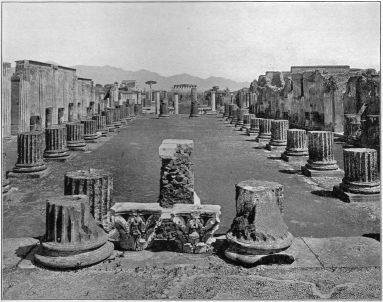
Photo. Sommer
the basilica at pompeii
|
|
1. I have observed, Emperor, that many in their treatises and volumes of commentaries on architecture have not presented the subject with well-ordered completeness, but have merely made a beginning and left, as it were, only desultory fragments. I have therefore thought that it would be a worthy and very useful thing to reduce the whole of this great art to a complete and orderly form of presentation, and then in different books to lay down and explain the required characteristics of different departments. Hence, Caesar, in my first book I have set forth to you the function of the architect and the things in which he ought to be trained. In the second I have discussed the supplies of material of which buildings are constructed. In the third, which deals with the arrangements of temples and their variety of form, I showed the nature and number of their classes, with the adjustments proper to each form according to the usage of the Ionic order, one of the three which exhibit the greatest delicacy of proportion in their symmetrical measurements. In the present book I shall speak of the established rules for the Doric and Corinthian orders, and shall explain their differences and peculiarities.
1. Corinthian columns are, excepting in their capitals, of the same proportions in all respects as Ionic; but the height of their capitals gives them proportionately a taller and more slender effect. This is because the height of the Ionic capital is only one third of the thickness of the column, while that of the Corinthian is the entire thickness of the shaft. Hence, as two thirds are added in Corinthian capitals, their tallness gives a more slender appearance to the columns themselves.
2. The other members which are placed above the columns, are, for Corinthian columns, composed either of the Doric proportions or according to the Ionic usages; for the Corinthian order never had any scheme peculiar to itself for its cornices or other ornaments, but may have mutules in the coronae and guttae on the architraves according to the triglyph system of the Doric style, or, according to Ionic practices, it may be arranged with a frieze adorned with sculptures and accompanied with dentils and coronae.
3. Thus a third architectural order, distinguished by its capital, was produced out of the two other orders. To the forms of their columns are due the names of the three orders, Doric, Ionic, and Corinthian, of which the Doric was the first to arise, and in early times. For Dorus, the son of Hellen and the nymph Phthia, was king of Achaea and all the Peloponnesus, and he built a fane, which chanced to be of this order, in the precinct of Juno at Argolis, a very ancient city, and subsequently others of the same order in the other cities of Achaea, although the rules of symmetry were not yet in existence.
4. Later, the Athenians, in obedience to oracles of the Delphic Apollo, and with the general agreement of all Hellas, despatched[103] thirteen colonies at one time to Asia Minor, appointing leaders for each colony and giving the command-in-chief to Ion, son of Xuthus and Creusa (whom further Apollo at Delphi in the oracles had acknowledged as his son). Ion conducted those colonies to Asia Minor, took possession of the land of Caria, and there founded the grand cities of Ephesus, Miletus, Myus (long ago engulfed by the water, and its sacred rites and suffrage handed over by the Ionians to the Milesians), Priene, Samos, Teos, Colophon, Chius, Erythrae, Phocaea, Clazomenae, Lebedos, and Melite. This Melite, on account of the arrogance of its citizens, was destroyed by the other cities in a war declared by general agreement, and in its place, through the kindness of King Attalus and Arsinoe, the city of the Smyrnaeans was admitted among the Ionians.
5. Now these cities, after driving out the Carians and Lelegans, called that part of the world Ionia from their leader Ion, and there they set off precincts for the immortal gods and began to build fanes: first of all, a temple to Panionion Apollo such as they had seen in Achaea, calling it Doric because they had first seen that kind of temple built in the states of the Dorians.
6. Wishing to set up columns in that temple, but not having rules for their symmetry, and being in search of some way by which they could render them fit to bear a load and also of a satisfactory beauty of appearance, they measured the imprint of a man's foot and compared this with his height. On finding that, in a man, the foot was one sixth of the height, they applied the same principle to the column, and reared the shaft, including the capital, to a height six times its thickness at its base. Thus the Doric column, as used in buildings, began to exhibit the proportions, strength, and beauty of the body of a man.
7. Just so afterwards, when they desired to construct a temple to Diana in a new style of beauty, they translated these footprints into terms characteristic of the slenderness of women, and thus first made a column the thickness of which was only one eighth of its height, so that it might have a taller look. At the[104] foot they substituted the base in place of a shoe; in the capital they placed the volutes, hanging down at the right and left like curly ringlets, and ornamented its front with cymatia and with festoons of fruit arranged in place of hair, while they brought the flutes down the whole shaft, falling like the folds in the robes worn by matrons. Thus in the invention of the two different kinds of columns, they borrowed manly beauty, naked and unadorned, for the one, and for the other the delicacy, adornment, and proportions characteristic of women.
8. It is true that posterity, having made progress in refinement and delicacy of feeling, and finding pleasure in more slender proportions, has established seven diameters of the thickness as the height of the Doric column, and nine as that of the Ionic. The Ionians, however, originated the order which is therefore named Ionic.
The third order, called Corinthian, is an imitation of the slenderness of a maiden; for the outlines and limbs of maidens, being more slender on account of their tender years, admit of prettier effects in the way of adornment.
9. It is related that the original discovery of this form of capital was as follows. A free-born maiden of Corinth, just of marriageable age, was attacked by an illness and passed away. After her burial, her nurse, collecting a few little things which used to give the girl pleasure while she was alive, put them in a basket, carried it to the tomb, and laid it on top thereof, covering it with a roof-tile so that the things might last longer in the open air. This basket happened to be placed just above the root of an acanthus. The acanthus root, pressed down meanwhile though it was by the weight, when springtime came round put forth leaves and stalks in the middle, and the stalks, growing up along the sides of the basket, and pressed out by the corners of the tile through the compulsion of its weight, were forced to bend into volutes at the outer edges.

Photo.
Sommer
the basilica at pompeii
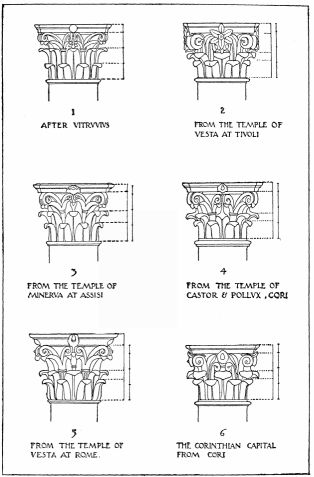
the
corinthian capital of vitruvius compared with the monuments
10. Just then Callimachus, whom the Athenians called κατατηξἱτεχνος for the refinement and delicacy of his artistic work,[106] passed by this tomb and observed the basket with the tender young leaves growing round it. Delighted with the novel style and form, he built some columns after that pattern for the Corinthians, determined their symmetrical proportions, and established from that time forth the rules to be followed in finished works of the Corinthian order.
11. The proportions of this capital should be fixed as follows. Let the height of the capital, including its abacus, be equivalent to the thickness of the base of a column. Let the breadth of the abacus be proportioned so that diagonals drawn from one corner of it to the other shall be twice the height of the capitals, which will give the proper breadth to each face of the abacus. The faces should curve inwards, by one ninth of the breadth of the face, from the outside edge of the corners of the abacus. At the bottom the capital should be of the thickness of the top of the column omitting the congé and astragal. The height of the abacus is one seventh of the height of the capital.
12. Omitting the height of the abacus, let the rest be divided into three parts, of which one should be given to the lowest leaf. Let the second leaf occupy the middle part of the height. Of the same height should be the stalks, out of which grow leaves projected so as to support the volutes which proceed from the stalks, and run out to the utmost corners of the abacus; the smaller spirals between them should be carved just under the flower which is on the abacus. The flowers on the four sides are to be made as large as the height of the abacus. On these principles of proportion, Corinthian capitals will be finished as they ought to be.
There are other kinds of capitals set upon these same columns and called by various names, but they have no peculiarities of proportion of which we can speak, nor can we recognize from them another order of columns. Even their very names are, as we can see, derived with some changes from the Corinthian, the cushion-shaped, and the Doric, whose symmetrical proportions have been thus transferred to delicate sculptures of novel form.[107]
1. Since the origin and invention of the orders of columns have been described above, I think it not out of place to speak in the same way about their ornaments, showing how these arose and from what original elements they were devised. The upper parts of all buildings contain timber work to which various terms are applied. And not only in its terminology but actually in its uses it exhibits variety. The main beams are those which are laid upon columns, pilasters, and antae; tie-beams and rafters are found in the framing. Under the roof, if the span is pretty large, are the crossbeams and struts; if it is of moderate extent, only the ridgepole, with the principal rafters extending to the outer edge of the eaves. Over the principal rafters are the purlines, and then above these and under the roof-tiles come the common rafters, extending so far that the walls are covered by their projection.
2. Thus each and every detail has a place, origin, and order of its own. In accordance with these details, and starting from carpenter's work, artists in building temples of stone and marble imitated those arrangements in their sculptures, believing that they must follow those inventions. So it was that some ancient carpenters, engaged in building somewhere or other, after laying the tie-beams so that they projected from the inside to the outside of the walls, closed up the space between the beams, and above them ornamented the coronae and gables with carpentry work of beauty greater than usual; then they cut off the projecting ends of the beams, bringing them into line and flush with the face of the walls; next, as this had an ugly look to them, they fastened boards, shaped as triglyphs are now made, on the ends of the beams, where they had been cut off in front, and painted them with blue wax so that the cutting off of the ends of the beams, being concealed, would not offend the eye. Hence it was in imitation of the arrangement of the tie-beams that men[108] began to employ, in Doric buildings, the device of triglyphs and the metopes between the beams.
3. Later, others in other buildings allowed the projecting principal rafters to run out till they were flush with the triglyphs, and then formed their projections into simae. From that practice, like the triglyphs from the arrangement of the tie-beams, the system of mutules under the coronae was devised from the projections of the principal rafters. Hence generally, in buildings of stone and marble, the mutules are carved with a downward slant, in imitation of the principal rafters. For these necessarily have a slanting and projecting position to let the water drip down. The scheme of triglyphs and mutules in Doric buildings was, therefore, the imitative device that I have described.
4. It cannot be that the triglyphs represent windows, as some have erroneously said, since the triglyphs are placed at the corners and over the middle of columns—places where, from the nature of the case, there can be no windows at all. For buildings are wholly disconnected at the corners if openings for windows are left at those points. Again, if we are to suppose that there were open windows where the triglyphs now stand, it will follow, on the same principle, that the dentils of the Ionic order have likewise taken the places of windows. For the term "metope" is used of the intervals between dentils as well as of those between triglyphs. The Greeks call the seats of tie-beams and rafters ὁπαἱ, while our people call these cavities columbaria (dovecotes). Hence, the space between the tie-beams, being the space between two "opae," was named by them μετὁπη.
5. The system of triglyphs and mutules was invented for the Doric order, and similarly the scheme of dentils belongs to the Ionic, in which there are proper grounds for its use in buildings. Just as mutules represent the projection of the principal rafters, so dentils in the Ionic are an imitation of the projections of the common rafters. And so in Greek works nobody ever put dentils under mutules, as it is impossible that common rafters should be underneath principal rafters. Therefore, if that which[109] in the original must be placed above the principal rafters, is put in the copy below them, the result will be a work constructed on false principles. Neither did the ancients approve of or employ mutules or dentils in pediments, but only plain coronae, for the reason that neither principal nor common rafters tail into the fronts of pediments, nor can they overhang them, but they are laid with a slope towards the eaves. Hence the ancients held that what could not happen in the original would have no valid reason for existence in the copy.
6. For in all their works they proceeded on definite principles of fitness and in ways derived from the truth of Nature. Thus they reached perfection, approving only those things which, if challenged, can be explained on grounds of the truth. Hence, from the sources which have been described they established and left us the rules of symmetry and proportion for each order. Following in their steps, I have spoken above on the Ionic and Corinthian styles, and I shall now briefly explain the theory of the Doric and its general appearance.
1. Some of the ancient architects said that the Doric order ought not to be used for temples, because faults and incongruities were caused by the laws of its symmetry. Arcesius and Pytheos said so, as well as Hermogenes. He, for instance, after getting together a supply of marble for the construction of a Doric temple, changed his mind and built an Ionic temple to Father Bacchus with the same materials. This is not because it is unlovely in appearance or origin or dignity of form, but because the arrangement of the triglyphs and metopes (lacunaria) is an embarrassment and inconvenience to the work.
2. For the triglyphs ought to be placed so as to correspond to the centres of the columns, and the metopes between the triglyphs[110] ought to be as broad as they are high. But in violation of this rule, at the corner columns triglyphs are placed at the outside edges and not corresponding to the centre of the columns. Hence the metopes next to the corner columns do not come out perfectly square, but are too broad by half the width of a triglyph. Those who would make the metopes all alike, make the outermost intercolumniations narrower by half the width of a triglyph. But the result is faulty, whether it is attained by broader metopes or narrower intercolumniations. For this reason, the ancients appear to have avoided the scheme of the Doric order in their temples.
3. However, since our plan calls for it, we set it forth as we have received it from our teachers, so that if anybody cares to set to work with attention to these laws, he may find the proportions stated by which he can construct correct and faultless examples of temples in the Doric fashion.
Let the front of a Doric temple, at the place where the columns are put up, be divided, if it is to be tetrastyle, into twenty-seven parts; if hexastyle, into forty-two. One of these parts will be the module (in Greek ἑμβἁτϛ); and this module once fixed, all the parts of the work are adjusted by means of calculations based upon it.
4. The thickness of the columns will be two modules, and their height, including the capitals, fourteen. The height of a capital will be one module, and its breadth two and one sixth modules. Let the height of the capital be divided into three parts, of which one will form the abacus with its cymatium, the second the echinus with its annulets, and the third the necking. The diminution of the column should be the same as described for Ionic columns in the third book. The height of the architrave, including taenia and guttae, is one module, and of the taenia, one seventh of a module. The guttae, extending as wide as the triglyphs and beneath the taenia, should hang down for one sixth of a module, including their regula. The depth of the architrave on its under side should answer to the necking at the top of the column. Above the [112]architrave, the triglyphs and metopes are to be placed: the triglyphs one and one half modules high, and one module wide in front. They are to be arranged so that one is placed to correspond to the centre of each corner and intermediate column, and two over each intercolumniation except the middle intercolumniations of the front and rear porticoes, which have three each. The intervals in the middle being thus extended, a free passage will be afforded to those who would approach the statues of the gods.
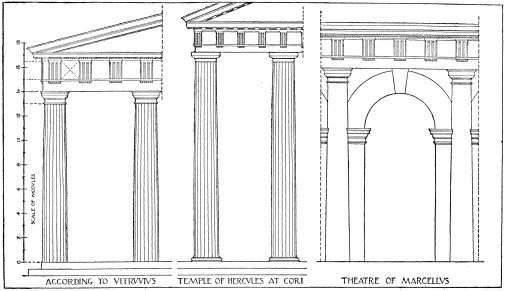
vitruvius'
doric order compared with the temple at cori and the doric order of
the theatre of marcellus
5. The width of the triglyph should be divided into six parts, and five of these marked off in the middle by means of the rule, and two half parts at the right and left. Let one part, that in the centre, form a "femur" (in Greek μηρὁς). On each side of it are the channels, to be cut in to fit the tip of a carpenter's square, and in succession the other femora, one at the right and the other at the left of a channel. To the outsides are relegated the semichannels. The triglyphs having been thus arranged, let the metopes between the triglyphs be as high as they are wide, while at the outer corners there should be semimetopes inserted, with the width of half a module.
In these ways all defects will be corrected, whether in metopes or intercolumniations or lacunaria, as all the arrangements have been made with uniformity.
6. The capitals of each triglyph are to measure one sixth of a module. Over the capitals of the triglyphs the corona is to be placed, with a projection of two thirds of a module, and having a Doric cymatium at the bottom and another at the top. So the corona with its cymatia is half a module in height. Set off on the under side of the corona, vertically over the triglyphs and over the middle of the metopes, are the viae in straight lines and the guttae arranged in rows, six guttae broad and three deep. The spaces left (due to the fact that the metopes are broader than the triglyphs) may be left unornamented or may have thunderbolts carved on them. Just at the edge of the corona a line should be cut in, called the scotia. All the other parts, such as tympana[113] and the simae of the corona, are to be constructed as described above in the case of the Ionic order.
7. Such will be the scheme established for diastyle buildings. But if the building is to be systyle and monotriglyphic, let the front of the temple, if tetrastyle, be divided into nineteen and a half parts; if hexastyle, into twenty-nine and a half parts. One of these parts will form the module in accordance with which the adjustments are to be made as above described.
8. Thus, over each portion of the architrave two metopes and two triglyphs[3] will be placed; and, in addition, at the corners half a triglyph and besides a space large enough for a half triglyph. At the centre, vertically under the gable, there should be room for three triglyphs and three metopes, in order that the centre intercolumniation, by its greater width, may give ample room for people to enter the temple, and may lend an imposing effect to the view of the statues of the gods.
9. The columns should be fluted with twenty flutes. If these are to be left plane, only the twenty angles need be marked off. But if they are to be channelled out, the contour of the channelling may be determined thus: draw a square with sides equal in length to the breadth of the fluting, and centre a pair of compasses in the middle of this square. Then describe a circle with a circumference touching the angles of the square, and let the channellings have the contour of the segment formed by the circumference and the side of the square. The fluting of the Doric column will thus be finished in the style appropriate to it.
10. With regard to the enlargement to be made in the column at its middle, let the description given for Ionic columns in the third book be applied here also in the case of Doric.
Since the external appearance of the Corinthian, Doric, and Ionic proportions has now been described, it is necessary next to explain the arrangements of the cella and the pronaos.[114]
1. The length of a temple is adjusted so that its width may be half its length, and the actual cella one fourth greater in length than in width, including the wall in which the folding doors are placed. Let the remaining three parts, constituting the pronaos, extend to the antae terminating the walls, which antae ought to be of the same thickness as the columns. If the temple is to be more than twenty feet in width, let two columns be placed between the two antae, to separate the pteroma from the pronaos. The three intercolumniations between the antae and the columns should be closed by low walls made of marble or of joiner's work, with doors in them to afford passages into the pronaos.
2. If the width is to be more than forty feet, let columns be placed inside and opposite to the columns between the antae. They should have the same height as the columns in front of them, but their thickness should be proportionately reduced: thus, if the columns in front are in thickness one eighth of their height, these should be one tenth; if the former are one ninth or one tenth, these should be reduced in the same proportion. For their reduction will not be discernible, as the air has not free play about them. Still, in case they look too slender, when the outer columns have twenty or twenty-four flutes, these may have twenty-eight or thirty-two. Thus the additional number of flutes will make up proportionately for the loss in the body of the shaft, preventing it from being seen, and so in a different way the columns will be made to look equally thick.
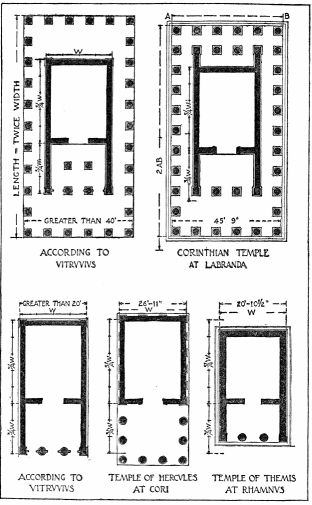
vitruvius'
temple plan compared with actual examples
3. The reason for this result is that the eye, touching thus upon a greater number of points, set closer together, has a larger compass to cover with its range of vision. For if two columns, equally thick but one unfluted and the other fluted, are measured by drawing lines round them, one line touching the body of the columns in the hollows of the channels and on the edges of the flutes,[116] these surrounding lines, even though the columns are equally thick, will not be equal to each other, because it takes a line of greater length to compass the channels and the flutes. This being granted, it is not improper, in narrow quarters or where the space is enclosed, to use in a building columns of somewhat slender proportions, since we can help out by a duly proportionate number of flutings.
4. The walls of the cella itself should be thick in proportion to its size, provided that their antae are kept of the same thickness as the columns. If the walls are to be of masonry, let the rubble used be as small as possible; but if they are to be of dimension stone or marble, the material ought to be of a very moderate and uniform size; for the laying of the stones so as to break joints will make the whole work stronger, and their bevelled edges, standing up about the builds and beds, will give it an agreeable look, somewhat like that of a picture.
1. The quarter toward which temples of the immortal gods ought to face is to be determined on the principle that, if there is no reason to hinder and the choice is free, the temple and the statue placed in the cella should face the western quarter of the sky. This will enable those who approach the altar with offerings or sacrifices to face the direction of the sunrise in facing the statue in the temple, and thus those who are undertaking vows look toward the quarter from which the sun comes forth, and likewise the statues themselves appear to be coming forth out of the east to look upon them as they pray and sacrifice.
2. But if the nature of the site is such as to forbid this, then the principle of determining the quarter should be changed, so that the widest possible view of the city may be had from the sanctuaries of the gods. Furthermore, temples that are to be built beside[117] rivers, as in Egypt on both sides of the Nile, ought, as it seems, to face the river banks. Similarly, houses of the gods on the sides of public roads should be arranged so that the passers-by can have a view of them and pay their devotions face to face.
1. For the doorways of temples and their casings the rules are as follows, first determining of what style they are to be. The styles of portals are Doric, Ionic, and Attic.
In the Doric, the symmetrical proportions are distinguished by the following rules. Let the top of the corona, which is laid above the casing, be on a level with the tops of the capitals of the columns in the pronaos. The aperture of the doorway should be determined by dividing the height of the temple, from floor to coffered ceiling, into three and one half parts and letting two and one half[4] thereof constitute the height of the aperture of the folding doors. Let this in turn be divided into twelve parts, and let five and a half of these form the width of the bottom of the aperture. At the top, this width should be diminished, if the aperture is sixteen feet in height, by one third the width of the door-jamb; if the aperture is from sixteen to twenty-five feet, let the upper part of it be diminished by one quarter of the jamb; if from twenty-five to thirty feet, let the top be diminished by one eighth of the jamb. Other and higher apertures should, as it seems, have their sides perpendicular.
2. Further, the jambs themselves should be diminished at the top by one fourteenth of their width. The height of the lintel should be equivalent to the width of the jambs at the top. Its cymatium ought to be one sixth of the jamb, with a projection equivalent to its height. The style of carving of the cymatium with its astragal should be the Lesbian. Above the cymatium of[118] the lintel, place the frieze of the doorway, of the same height as the lintel, and having a Doric cymatium and Lesbian astragal carved upon it. Let the corona and its cymatium at the top of all be carved without ornamentation, and have a projection equal to its height. To the right and left of the lintel, which rests upon the jambs, there are to be projections fashioned like projecting bases and jointed to a nicety with the cymatium itself.
3. If the doorways are to be of the Ionic style, the height of the aperture should be reached in the same manner as in the Doric. Let its width be determined by dividing the height into two and one half parts and letting one of them form the width at the bottom. The diminutions should be the same as for Doric. The width of the faces of the jambs should be one fourteenth of the height of the aperture, and the cymatium one sixth of the width. Let the rest, excluding the cymatium, be divided into twelve parts. Let three of these compose the first fascia with its astragal, four the second, and five the third, the fasciae with their astragals running side by side all round.
4. The cornices of Ionic doorways should be constructed in the same manner as those of Doric, in due proportions. The consoles, otherwise called brackets, carved at the right and left, should hang down to the level of the bottom of the lintel, exclusive of the leaf. Their width on the face should be two thirds of the width of the jamb, but at the bottom one fourth slenderer than above.
Doors should be constructed with the hinge-stiles one twelfth of the width of the whole aperture. The panels between two stiles should each occupy three of the twelve parts.
5. The rails will be apportioned thus: divide the height into five parts, of which assign two to the upper portion and three to the lower; above the centre place the middle rails; insert the others at the top and at the bottom. Let the height of a rail be one third of the breadth of a panel, and its cymatium one sixth of the rail. The width of the meeting-stiles should be one half the rail, and the cover-joint two thirds of the rail. The stiles toward[120] the side of the jambs should be one half the rail. If the doors have folds in them, the height will remain as before, but the width should be double that of a single door; if the door is to have four folds, its height should be increased.

vitruvius'
rule for doorways compared with two examples
6. Attic doorways are built with the same proportions as Doric. Besides, there are fasciae running all round under the cymatia on the jambs, and apportioned so as to be equal to three sevenths of a jamb, excluding the cymatium. The doors are without lattice-work, are not double but have folds in them, and open outward.
The laws which should govern the design of temples built in the Doric, Ionic, and Corinthian styles, have now, so far as I could arrive at them, been set forth according to what may be called the accepted methods. I shall next speak of the arrangements in the Tuscan style, showing how they should be treated.
1. The place where the temple is to be built having been divided on its length into six parts, deduct one and let the rest be given to its width. Then let the length be divided into two equal parts, of which let the inner be reserved as space for the cellae, and the part next the front left for the arrangement of the columns.
2. Next let the width be divided into ten parts. Of these, let three on the right and three on the left be given to the smaller cellae, or to the alae if there are to be alae, and the other four devoted to the middle of the temple. Let the space in front of the cellae, in the pronaos, be marked out for columns thus: the corner columns should be placed opposite the antae on the line of the outside walls; the two middle columns, set out on the line of the walls which are between the antae and the middle of the temple; and through the middle, between the antae and the front columns, a second row, arranged on the same lines. Let the thickness of the columns at the bottom be one seventh of their height, their height one third of the width of the temple, and the diminution of a column at the top, one fourth of its thickness at the bottom.
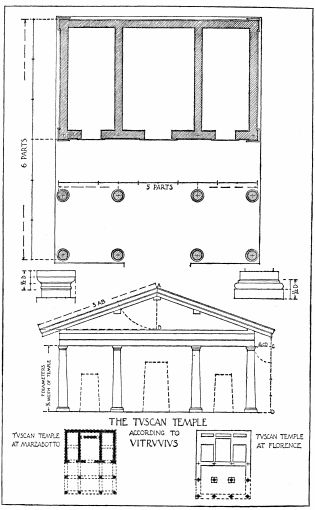
the
tuscan temple according to vitruvius.
3. The height of their bases should be one half of that thickness. The plinth of their bases should be circular, and in height one half the height of the bases, the torus above it and congé being of the same height as the plinth. The height of the capital is one half the thickness of a column. The abacus has a width equivalent to the thickness of the bottom of a column. Let the height of the capital be divided into three parts, and give one to the plinth (that is, the abacus), the second to the echinus, and the third to the necking with its congé.
4. Upon the columns lay the main beams, fastened together, to a height commensurate with the requirements of the size of the building. These beams fastened together should be laid so as to be equivalent in thickness to the necking at the top of a column, and should be fastened together by means of dowels and dove-tailed tenons in such a way that there shall be a space two fingers broad between them at the fastening. For if they touch one another, and so do not leave airholes and admit draughts of air to blow between them, they get heated and soon begin to rot.
5. Above the beams and walls let the mutules project to a distance equal to one quarter of the height of a column; along the front of them nail casings; above, build the tympanum of the pediment either in masonry or in wood. The pediment with its ridgepole, principal rafters, and purlines are to be built in such a way that the eaves shall be equivalent to one third of the completed roof.
1. There are also circular temples, some of which are constructed in monopteral form, surrounded by columns but without a cella, while others are termed peripteral. Those that are without a cella have a raised platform and a flight of steps leading to it, one third of the diameter of the temple. The columns upon the stylobates are constructed of a height equivalent to the diameter taken between the outer edges of the stylobate walls, and of a thickness equivalent to one tenth of their height including the capitals and bases. The architrave has the height of one half of the thickness of a column. The frieze and the other parts placed above it are such as I have described in the third[5] book, on the subject of symmetrical proportions.
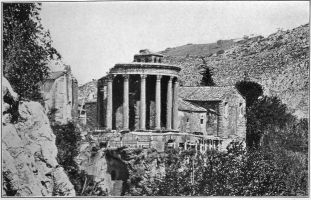
Photo.
Anderson
the circular temple at tivoli
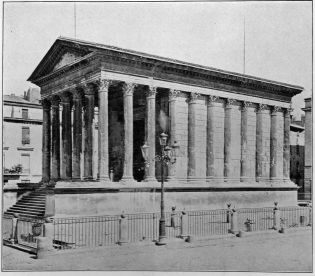
the
maison carrée at nîmes, a pseudo-peripteral temple
|
|
temple at tivoli |
plan of the temple |
2. But if such a temple is to be constructed in peripteral form, let two steps and then the stylobate be constructed below. Next, let the cella wall be set up, recessed within the stylobate about one fifth of the breadth thereof, and let a place for folding doors be left in the middle to afford entrance. This cella, excluding its walls and the passage round the outside, should have a diameter equivalent to the height of a column above the stylobate. Let[124] the columns round the cella be arranged in the symmetrical proportions just given.
3. The proportions of the roof in the centre should be such that the height of the rotunda, excluding the finial, is equivalent to one half the diameter of the whole work. The finial, excluding its pyramidal base, should have the dimensions of the capital of a column. All the rest must be built in the symmetrical proportions described above.

From
Durm
the circular temple according to vitruvius
4. There are also other kinds of temples, constructed in the same symmetrical proportions and yet with a different kind of plan: for example, the temple of Castor in the district of the Circus Flaminius, that of Vejovis between the two groves, and still more ingeniously the temple of Diana in her sacred grove, with columns added on the right and left at the flanks of the pronaos. Temples of this kind, like that of Castor in the Circus, were first built in Athens on the Acropolis, and in Attica at Sunium to Pallas Minerva. The proportions of them are not different, but the same as usual. For the length of their cellae is twice the width, as in other temples; but all that we regularly find in the fronts of others is in these transferred to the sides.[125]
5. Some take the arrangement of columns belonging to the Tuscan order and apply it to buildings in the Corinthian and Ionic styles, and where there are projecting antae in the pronaos, set up two columns in a line with each of the cella walls, thus making a combination of the principles of Tuscan and Greek buildings.
6. Others actually remove the temple walls, transferring them to the intercolumniations, and thus, by dispensing with the space needed for a pteroma, greatly increase the extent of the cella. So, while leaving all the rest in the same symmetrical proportions, they appear to have produced a new kind of plan with the new name "pseudoperipteral." These kinds, however, vary according to the requirements of the sacrifices. For we must not build temples according to the same rules to all gods alike, since the performance of the sacred rites varies with the various gods.
7. I have now set forth, as they have come down to me, all the principles governing the building of temples, have marked out under separate heads their arrangements and proportions, and have set forth, so far as I could express them in writing, the differences in their plans and the distinctions which make them unlike one another. Next, with regard to the altars of the immortal gods, I shall state how they may be constructed so as to conform to the rules governing sacrifices.
Altars should face the east, and should always be placed on a lower level than are the statues in the temples, so that those who are praying and sacrificing may look upwards towards the divinity. They are of different heights, being each regulated so as to be appropriate to its own god. Their heights are to be adjusted thus: for Jupiter and all the celestials, let them be constructed as high as possible; for Vesta and Mother Earth, let them be built[126] low. In accordance with these rules will altars be adjusted when one is preparing his plans.
Having described the arrangements of temples in this book, in the following we shall give an exposition of the construction of public buildings.[127]
|
Ancient Greece |
Medieval Greece / Byzantine Empire |
Modern Greece |
|---|---|---|
|
Science, Technology , Medicine , Warfare |
Science, Technology, Arts |
Cities, Islands, Regions, Fauna/Flora , |
